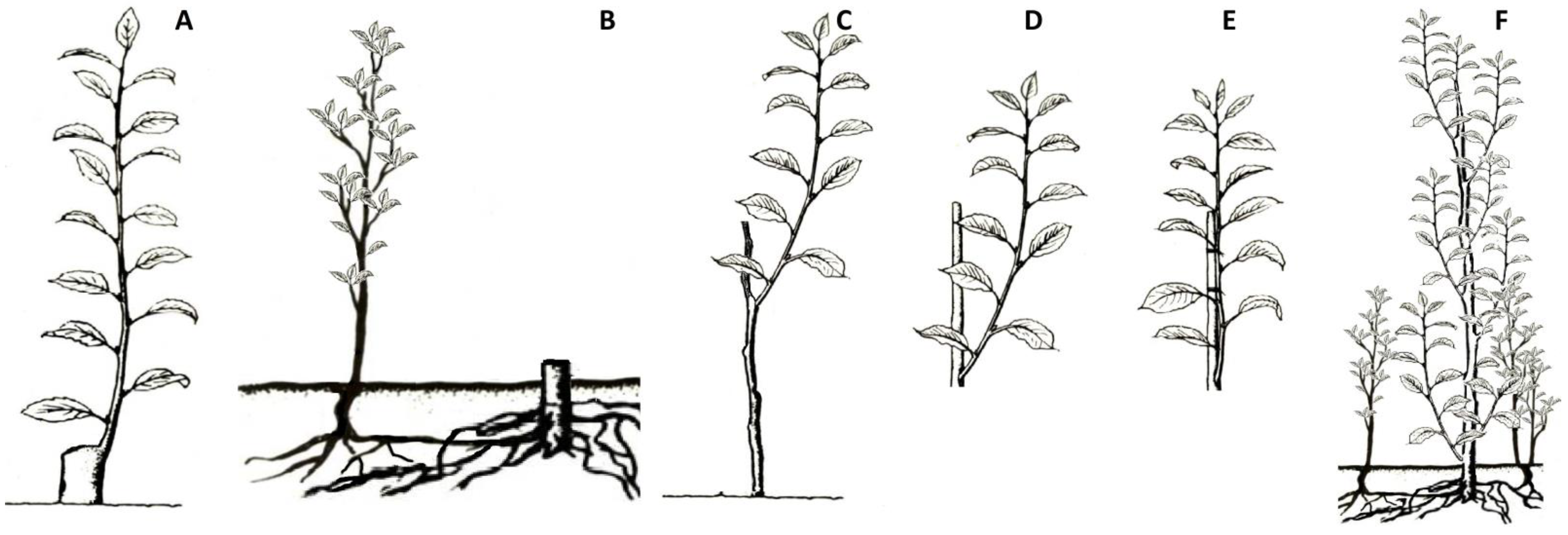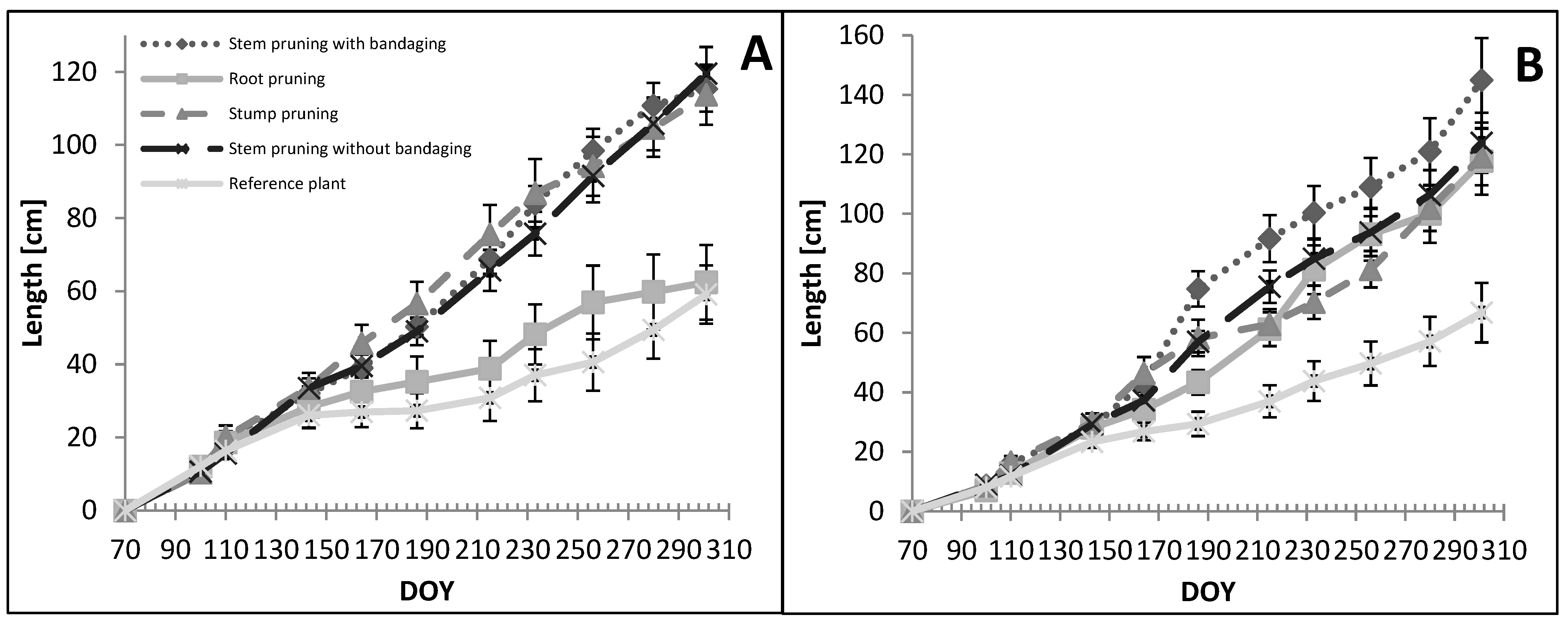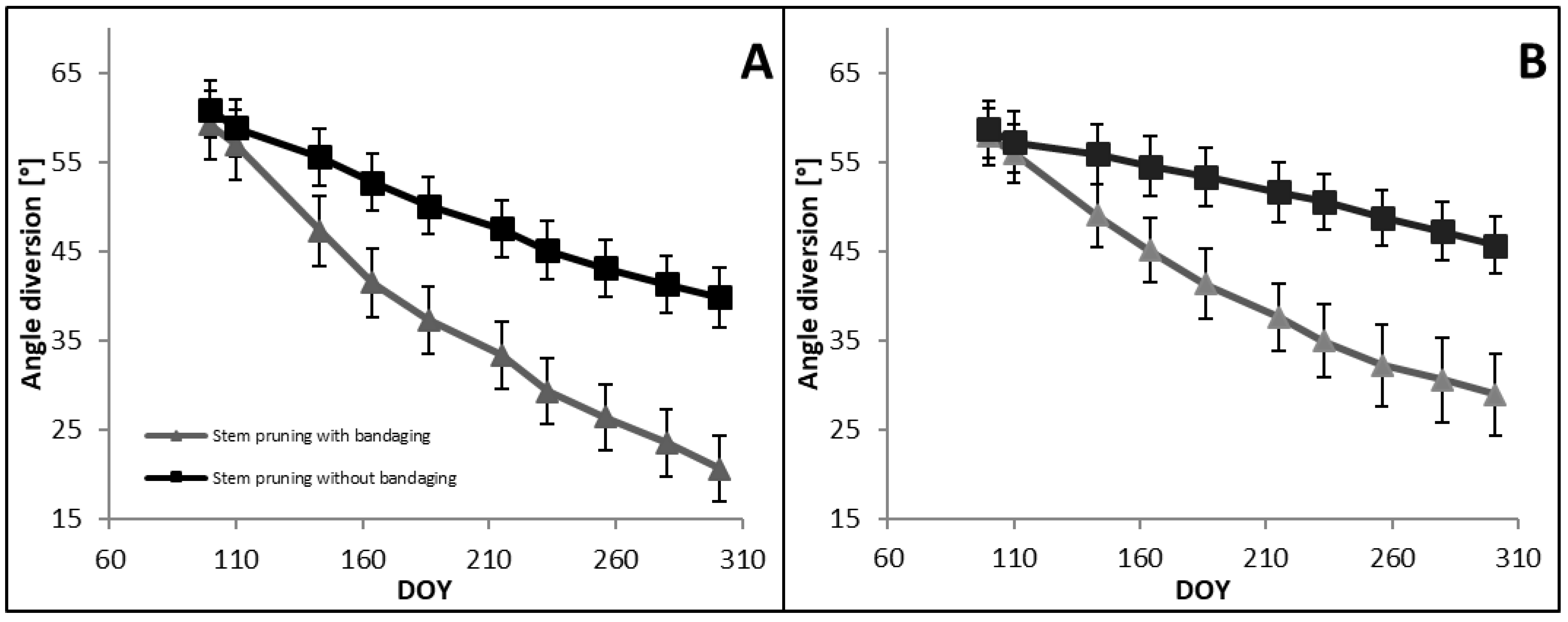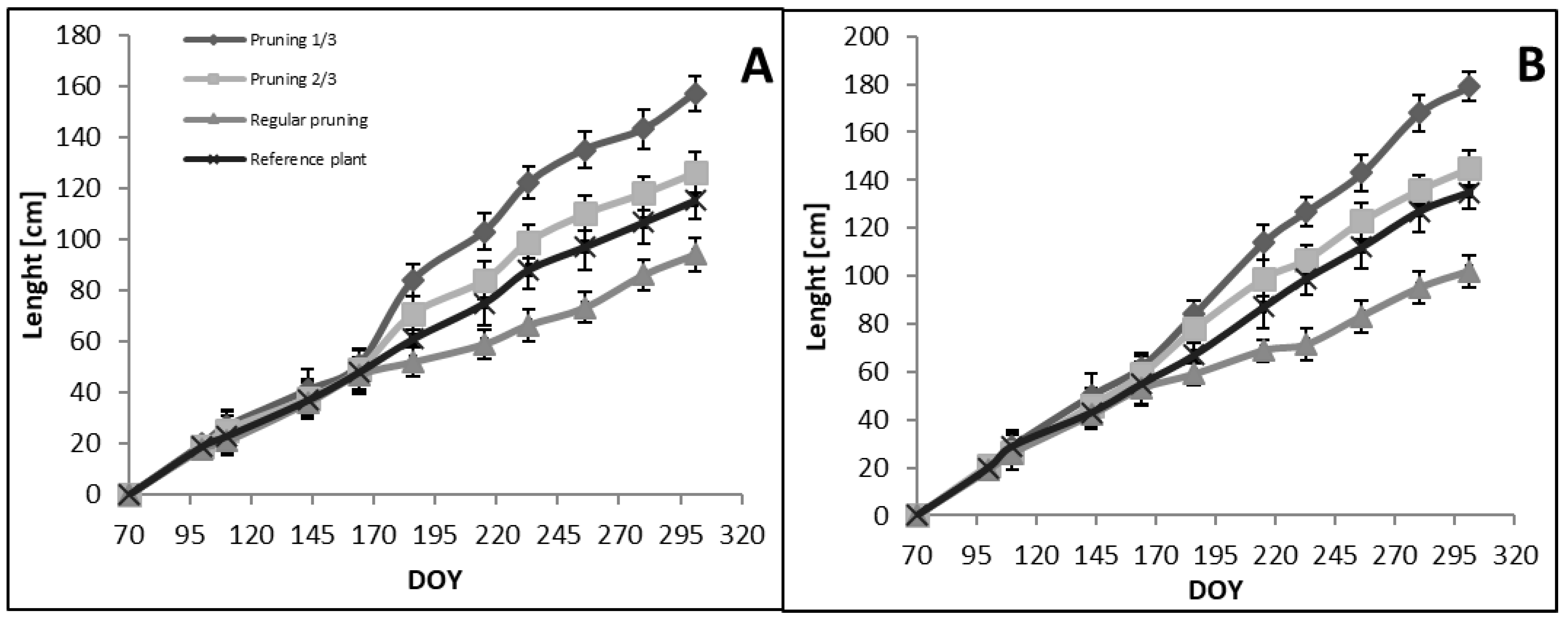Impact of Different Pruning Practices on Height Growth of Paulownia Clon in Vitro 112®
Abstract
:1. Introduction
- Whether one-year-old and two-year-old plants produce branches and root, stem and stump shoots, and, if yes, how many.
- Whether bandaging of the stem sprout to the stem influences the straightness of the stem while pruning—we tried to reduce the angle between the axis of the original stem and that of the new sprout.
- Whether it is possible to achieve a greater height growth of the tree in the event that a different type of sprout (stem, stump, root) is supported after apical bud frost injury (i.e., spring pruning).
- Whether the plant grows faster with year-long pruning (i.e., the removal of different volumes of branches and leaves).
2. Materials and Methods
2.1. Spring Pruning
- Stump pruning, where the plant was cut on the 70th DOY (leaving a maximum 5 cm stump) and, on the 100th DOY, the thickest stump sprout was left, and all the other sprouts were removed (Figure 1).
- Root pruning, where the plant was cut on the 70th DOY (leaving a maximum 5 cm stump) and, on the 100th DOY, the thickest root sprout was left, and all the other sprouts were removed (Figure 1).
- Stem pruning, where, on the 100th DOY, the thickest stem sprout was left, and the rest of the plant (approximately 10 cm above that sprout) was removed, together with all the other sprouts. Stem pruning was carried out in two different ways:
- Reference plant, where the plant with sprouts was left to grow naturally (Figure 1).
2.2. Year-Long Pruning
- Pruning ⅓, where the lowest ⅓ of the leaves and branches was removed from the plant on the 151st DOY.
- Pruning ⅔, where the lowest ⅔ of the leaves and branches were removed from the plant on the 151st DOY.
- Regular pruning, where the lowest leaves were removed from the plant (on the 151st DOY), so only the last four rows of the leaves growing opposite each other remained, and each began regular removal of leaves approximately 14 days from this date.
- Reference plant, where the plant with sprouts was left to grow naturally.
2.3. Sprouting Capacity and Branching
3. Results
3.1. Spring Pruning
3.2. Year-Long Pruning
3.3. Sprouting Capacity and Branching
4. Discussion
5. Conclusions
- The plants with stem or stump pruning grew higher than those with root pruning and the reference plants.
- The reference plants became bushy and had slow growth. We do not recommend leaving the plants without pruning.
- When we used root pruning, the new plants grew slowly, and they were smaller than those with the other variants of pruning (including the reference plants) at the end of the vegetation period. We do not recommend root pruning.
- We found out that the best pruning (according to the growth of the plants) was stem pruning.
- Next, with an almost insignificant difference, were the plants with root pruning and stump pruning.
- It is important to carry out some pruning and not leave the plant to grow naturally. We do not recommend leaving the plants without pruning.
- The best year-long pruning (according to the growth of the plants) seems to be pruning ⅓.
- The reference plants became bushy and had slow growth. We do not recommend leaving the plants without pruning.
- Plants with the pruning ⅔ variant had similar growth to the reference plants. We do not recommend pruning ⅔.
- The plants with regular pruning were smaller, even compared to the reference plants. We definitely do not recommend using regular pruning.
Author Contributions
Funding
Informed Consent Statement
Data Availability Statement
Acknowledgments
Conflicts of Interest
References
- Smiley, C.J. A Record of Paulownia in the Tertiary of North America. Am. J. Bot. 1961, 48, 175–179. [Google Scholar] [CrossRef]
- Úradníček, L. Paulovnie plstnatá [Paulownia tomentosa]. Lesnická Práce 2013, 5, 36–41. (In Czech) [Google Scholar]
- Bergmann, B.A.; Rubin, A.R.; Campbell, C.R. Potential of Paulownia elongata trees for swine waste utilization. Am. Soc. Agric. Eng. 1997, 40, 1733–1738. [Google Scholar] [CrossRef]
- Hieke, K. Praktická Dendrologie 2 [Practical dendrology Vol 2]; SZN: Praha, Czech Republic, 1978; p. 590. (In Czech) [Google Scholar]
- Görner, T. Pěstování paulovnie pro energetické účely [Planting of Paulownia for energy purposes]. Ochrana Přírody 2017, 3, 23–24. (In Czech) [Google Scholar]
- Icka, P.; Damo, R.; Icka, E. Paulownia tomentosa, a Fast Growing Timber. 2016. Available online: https://www.degruyter.com/downloadpdf/j/agr.2016.10.issue-1/agr-2016-0003/agr-2016-0003.pdf (accessed on 20 January 2022).
- Bikfalvi, M. Paulownia—The Intelligent Tree. 2014. Available online: http://www.paulowniagreene.ro/wp-content/uploads/2012/11/Paulownia-Clon-in-Vitro-and-Paulownia-Cotevisa-2-Presentation-EN.pdf (accessed on 20 January 2022).
- Ates, S.; Ni, Y.; Akgul, M.; Tozluoglu, A. Characterization and evaluation of Paulownia elongata as a raw material for paper production. Afr. J. Biotechnol. 2008, 7, 4153–4158. [Google Scholar]
- Yadav, N.K.; Vaidya, B.N.; Henderson, K.; Frost Lee, J.; Stewart, W.M.; Dhekney, S.A.; Joshee, N. A Review of Paulownia Biotechnology: A Short Rotation, Fast Growing Multipurpose Bioenergy Tree. Am. J. Plant Sci. 2013, 4, 2070–2082. [Google Scholar] [CrossRef] [Green Version]
- García-Morote, F.A.; López-Serrano, F.R.; Martínez-García, E.; Andrés-Abellán, M.; Dadi, T.; Candel, D.; Rubio, E.; Lucas-Borja, M.E. Stem Biomass Production of Paulownia elongata × P. fortunei under Low Irrigation in a Semi-Arid Environment. Forests 2014, 5, 2505–2520. [Google Scholar] [CrossRef] [Green Version]
- Akyildiz, M.H.; Hamiyet, S.K. Some technological properties and uses of paulownia (Paulownia tomentosa Steud.) wood. J. Environ. Biol. Triveni Enterp. 2010, 31, 351–355. (In Indian) [Google Scholar]
- Zhu, Z.-H.; Chao, C.-J.; Lu, X.-Y.; Xiong, Y.G. Paulownia in China: Cultivation and Utilization. 1986. Available online: https://paulowniamp.files.wordpress.com/2010/05/paulownia-in-china.pdf (accessed on 20 January 2022).
- UCLM. Badanie wartości gospodarczej odmian (VCU). Testowanie clon in vitro 112. Hibrid Paulownia elongace × Paulownia fortunei. Sprawozdanie techniczne (Czerwiec 2013). [The Economic Value of Varieties (VCU) Survey. Testing clon in vitro 112. Hybrid Paulownia elongace × Paulownia fortunei. Technical Report (June 2013).]. 2013. Available online: http://x-plus.pl/wp-content/uploads/oxytree-vcu_report-PL.pdf (accessed on 20 January 2022). (In Polish).
- Středa, T.; Středová, H.; Rožnovský, J. Podmínky pro přezimování polních plodin v kontextu vývoje klimatu [Conditions for overwintering field crops in the context of climate development]. In Úroda. Sborník Referátů; Salaš, P., Ed.; Lednice 20; 2011; pp. 582–589. Available online: www.cbks.cz/rostliny2011/prispevky/StredaStredovaRoznovsky.pdf (accessed on 20 January 2022). (In Czech)
- Mauer, O. Zakládání Lesů I. Učební Text [Forest Establishment I. Learning Text]; Mendelova Univerzita: Brno, Czech Republic, 2009; p. 172. (In Czech) [Google Scholar]
- Kincl, M.; Krpeš, V. Základy Fyziologie Rostlin [Basics of Plant Physiology]; Montanex: Ostrava, Czech Republic, 2000; p. 221. (In Czech) [Google Scholar]
- Nárovcová, J.; Nárovec, V.; Čermák, M. Netvárnost borovice lesní v nejmladších kulturách. Lesnická Práce 2004, 8, 8–9. (In Czech) [Google Scholar]
- Rahman, M.A.; Rahman, F.; Rahmatulla, M. In vitro regeneration of Paulownia tomentosa Steud. plants through the induction of adventitious sprouts in explants derived from selected mature trees, by studying the effect of different plant growth regulators. Am.-Eurasian J. Sustain. Agric. 2013, 7, 280–289. [Google Scholar]
- Polanský, B. Pěstění Lesů II [Silviculture Vol. II]; SZN: Praha, Czech Republic, 1955; p. 427. (In Czech) [Google Scholar]
- Vyskot, M. Pěstění Lesů [Silviculture]; SZN: Praha, Czech Republic, 1978; p. 432. (In Czech) [Google Scholar]
- Hrynkiewicz-Sudnik, J.; Sękowski, B.; Wilczkiewicz, M. Rozmnażanie Drzew i Krzewów Liściastych 1–3 [Reproduction of Deciduous Trees and Bushes 1–3]; Państwowe Wydawnictwo Naukowe: Warsaw, Poland, 1990; p. 855. (In Poland) [Google Scholar]
- Leonardsson, J.; Götmark, F. Differential survival and growth of stumps in 14 woody species after conservation thinning in mixed oak-rich temperate forests. Eur. J. For. Res. 2014, 134, 199–209. [Google Scholar] [CrossRef]
- Tesař, V.; Chroust, Z.; Kantor, P.; Peňáz, J.; Vacek, S.; Henžlík, V.; Kouba, J.; Materna, V.; Poleno, Z.; Worel, J.; et al. Pěstování v Heslech. Studijní Příručka [Silviculture in Keyword. Study Guide]; MZLU: Brno, Czech Republic, 1996; p. 95. (In Czech) [Google Scholar]
- Souček, J. Podrost v dubovém porostu s rozdílnou výchovou [Undergrowth in oak stands with different thinning]. Zprávy Lesnického Výzkumu 2009, 54, 17–22. (In Czech) [Google Scholar]
- Burda, P.; Nárovcová, J.J.; Nárovec, V.; Kuneš, I.; Baláš, M.; Machovič, I. Technologie Pěstování Listnatých Poloodrostků a Odrostků nové Generace v Lesních Školkách. Certifikovaná Metodika [Technology of Planting Deciduous Semi-Sapling and Sapling of New Generation in forest nurseries. Certified Methodology]; Výzkumý ústav lesního hospodářství a myslivosti, v.v.i.; Jíloviště-Strnady: Jiloviště-Strnady, Czech Republic, 2015; p. 56. (In Czech) [Google Scholar]
- Neilsen, W.A.; Pinkard, E.A. Developing silvicultural regimes for sawlog and veneer production from temperate eucalypt plantations in Tasmania. In Proceedings of the Conference on XII SILVOTECNA. Eucalypts in Chile, Present and Future Conception, Valdivia, Chile; 1999; p. 27. [Google Scholar]
- Waugh, G.; Yang, J.L. Opportunities for sawn products from Tasmanian plantation eucalypts. In Proceedings of the Conference on Faces of Farm Forestry, Australian Forest Growers, Launceston, Tasmania, Australia, 25th April–1st May 1994; pp. 215–220. [Google Scholar]
- Funk, D.T. Stem form response to repeated pruning of young black walnut trees. Can. J. For. Res. 1979, 9, 114–116. [Google Scholar] [CrossRef]
- Lückhoff, H.A. Pruning of Eucalyptus grandis. For. S. Afr. 1967, 8, 75–85. [Google Scholar]
- Bredenkamp, B.V.; Malan, F.S.; Conradie, W.E. Some effects of pruning on growth and timber quality of Eucalyptus grandis in Zululand. S. Afr. For. J. 1980, 11, 29–34. [Google Scholar] [CrossRef]
- Historical Data—Weather—Historical Data. 2020. Available online: http://portal.chmi.cz/historicka-data/pocasi/zakladni-informace?l=en (accessed on 20 January 2022).
- OXYTREE SOLUTIONS s.r.o., Brno IČO 05211468 Obchodní Rejstřík Firem [OXYTREE SOLUTIONS Ltd., Brno CIN 05211468 European Business Register]. 2021. Available online: https://rejstrik-firem.kurzy.cz/05211468/oxytree-solutions-sro/ (accessed on 20 January 2022).
- Paulownia Clon In Vitro 112®. 2021. Available online: https://www.paulownia112.com/#paulownia (accessed on 20 January 2022).
- Paulownia Clon In Vitro 112. Paulownia Clon In Vitro 112 International Trademark (WIPO) Information. 2013. Available online: https://trademark.trademarkia.com/wipo/trademark-1181727.htm?fbclid=IwAR1dQ61B8u38SRXBZAUJhgFl8nSCpihv7dSPguuIh2Ipbp01IHoc77Eo9OM (accessed on 20 January 2022).
- Cerro-Barja Del, A. Informe del Proyecto de Investigación: “Forestación de Zonas Semiráridas de Castilla-La Mancha noc Paulownia spp.”. [Information from the Investigation Project: “Forest of Semi-Arid Areas of Castilla-La Mancha noc Paulownia spp.”]. 2009. Available online: https://www.paulownia112.com/wp-content/uploads/2015/10/INFORME-FINAL-PAULOW.pdf (accessed on 20 January 2022). (In Spain).
- SPPK A02. Nature and Landscape Management Standards. Pruning of Trees; MENDELU: Brno, Czech Republic, 2015; p. 32. [Google Scholar]
- Jabloński, D. Surowiec Drzewny. Oxytree: Drewno do Przerobu w Tartaku w 6 lat od Posadzenia Drzewa [Wood Raw Material. Oxytree: Wood for Processing at a Sawmill 6 Years after Planting the Tree]. 2016. Available online: http://www.drewno.pl/artykuly/10535,oxytree-drewno-do-przerobu-w-tartaku-w-6-lat-od-posadzenia-drzewa.html (accessed on 20 January 2022). (In Polish).
- Oxytree. Investice do Budoucnosti! [Investing in the Future!]. 2016. Available online: http://oxytree.cz/co-je-oxytree/ (accessed on 20 January 2022). (In Czech).
- Josten, E.; Reiche, T.; Wittechen, B. Dřevo a Jeho Obrábění [Wood and Its Machining]; Grada: Praha, Czech Republic, 2010; p. 336. (In Czech) [Google Scholar]
- Vyskot, M. Základy Růstu a Produkce Lesů [Basics of Forest Growth and Production]; SZN: Praha, Czech Republic, 1971; p. 440. (In Czech) [Google Scholar]
- Givnish, T.J. Biochemical constraints on crown geometry in forest herbs. In On the Economy of Plant Form and Function. Proceedings of the Sixth Maria Moors Cabot Symposium, Evolutionary Constraints on Primary Productivity: Adaptive Patterns of Energy Capture in Plants; Givnish, T.J., Ed.; Cambridge University Press: Cambridge, UK, 1986; pp. 525–583. [Google Scholar]
- Friend, A.D. The prediction and physiological significance of tree height. In Vegetation Dynamics and Global Change; Solomon, M., Shugart, H.H., Eds.; Springer: Boston, MA, USA, 1993; pp. 101–115. [Google Scholar]
- Niinemets, U. Distribution patterns of carbon and nitrogen as affected by tree dimensions and relative light conditions in the canopy of Picea abies. Trees 1997, 11, 144–154. [Google Scholar] [CrossRef]
- UEWPI. Doporučená Pravidla pro Měření a Třídění Dříví v ČR 2008 [Recommended Rules for Measuring and Sorting Wood in the Czech Republic 2008]; Lesnická Práce: Praha, Czech Republic, 2007; p. 147. (In Czech) [Google Scholar]




| Experiment | Variant | Average Height (± SD) [cm] | SS | Average Thickness (± SD) [mm] | SS |
|---|---|---|---|---|---|
| Plants planted in 2016 | |||||
| Spring pruning | Stump | 72.5 (±24.9) | Ns | 17.6 (±5.6) | ns |
| Root | 72.6 (±28.2) | Ns | 17.4 (±6.1) | ns | |
| Stem with bandaging | 75.2 (±19.1) | Ns | 16.8 (±5.4) | ns | |
| Stem without bandaging | 74.6 (±18.6) | Ns | 17.9 (±4.8) | ns | |
| Reference plant | 76.0 (±17.9) | Ns | 16.0 (±4.2) | ns | |
| Year-long pruning | Pruning ⅓ | 77.5 (±22.7) | Ns | 18.9 (±5.0) | ns |
| Pruning ⅔ | 74.9 (±20.3) | Ns | 17.1 (±5.1) | ns | |
| Regular pruning | 73.4 (±19.7) | Ns | 15.9 (±5.2) | ns | |
| Reference plant | 72.8 (±21.2) | Ns | 17.8 (±4.5) | ns | |
| Plants planted in 2017 | |||||
| Spring pruning | Stump | 61.6 (±14.4) | Ns | 12.2 (±4.6) | ns |
| Root | 62.3 (±18.4) | Ns | 12.4 (±6.3) | ns | |
| Stem with bandaging | 64.6 (±15.7) | Ns | 11.3 (±4.2) | ns | |
| Stem without bandaging | 63.6 (±16.6) | Ns | 12.4 (±4.1) | ns | |
| Reference plant | 62.1 (±15.1) | Ns | 12.3 (±4.9) | ns | |
| Year-long pruning | Pruning ⅓ | 62.4 (±13.6) | Ns | 12.4 (±4.1) | ns |
| Pruning ⅔ | 64.1 (±11.5) | Ns | 13.4 (±4.7) | ns | |
| Regular pruning | 62.3 (±12.8) | ns | 13.1 (±4.5) | ns | |
| Reference plant | 62.1 (±14.3) | ns | 12.9 (±4.5) | ns | |
| One-year-old plants | |||||
| DOY | Variant | Stem sprout with bandaging | Stem sprout without bandaging | Stump sprout | |
| 186th | Reference plant | 46% (p = 0.0001) | 44% (p = 0.0018) | 52% (p = 0.0001) | |
| Root sprout | 30% (p = 0.0062) | 28% (p = 0.0058) | 38% (p = 0.0086) | ||
| 301st | Reference plant | 46% (p = 0.0001) | 48% (p = 0.0001) | 45% (p = 0.0001) | |
| Root sprout | 49% (p = 0.0009) | 51% (p = 0.0001) | 48% (p = 0.0001) | ||
| Two-year-old plants | |||||
| DOY | Variant | Stem sprout with bandaging | Stump sprout | Stem sprout without bandaging | Root sprout |
| 186th | Stem sprout without bandaging | 24% (p = 0.0058) | |||
| Stump sprout | 22% (p = 0.0068) | ||||
| Root sprout | 42% (p = 0.0032) | 26% (p = 0.0075) | 24% (p = 0.0089) | ||
| Reference plant | 61% (p = 0.0004) | 50% (p = 0.0032) | 48% (p = 0.0002) | 32% (p = 0.0045) | |
| Stem sprout without bandaging | 14% (p = 0.0174) | ||||
| 301st | Root sprout | 19% (p = 0.0168) | |||
| Stump sprout | 18% (p = 0.0423) | ||||
| Reference plant | 54% (p = 0.0021) | 44% (p = 0.0023) | 46% (p = 0.0025) | 43% (p = 0.003) | |
| One-year-old plants | ||||
| Day of year | Variant | ⅓ pruning | ⅔ pruning | Reference plant |
| 186th | ⅔ pruning | 15% (p = 0.0365) | ||
| Reference plant | 27% (p = 0.0097) | |||
| Regular pruning | 38% (p = 0.0071) | 27% (p = 0.0104) | 14% (p = 0.0345) | |
| 301st | ⅔ pruning | 20% (p = 0.0145) | ||
| Reference plant | 27% (p = 0.0066) | |||
| Regular pruning | 40% (p = 0.0024) | 25% (p = 0.0128) | 18% (p = 0.0172) | |
| Two-year-old plants | ||||
| DOY | Variant | ⅓ pruning | ⅔ pruning | Reference plant |
| 186th | Reference plant | 30% (p = 0.0249) | 24% (p = 0.0217) | |
| Regular pruning | 20% (p = 0.0347) | 14% (p = 0.0422) | ||
| 301st | ⅔ pruning | 23% (p = 0.0004) | ||
| Reference plant | 25% (p = 0.0002) | |||
| Regular pruning | 43% (p = 0.0001) | 30% (p = 0.0001) | 24% (p = 0.0003) | |
| Number of Sprouts/Branches (Groups) | |||||||||||
|---|---|---|---|---|---|---|---|---|---|---|---|
| 0 | 1 | 2 | 3 | 4 | 5 | 6 | 7 | 8 | 9 | Sum | |
| One-year-old plants (planted in 2017) | |||||||||||
| All sprouts | 19.4 | 6.2 | 9.4 | 16.7 | 12.2 | 10.4 | 10.4 | 8.4 | 5.7 | 1.2 | 100.0 |
| Root sprout | 44.4 | 11.4 | 8.9 | 8.4 | 7.5 | 6.5 | 6.8 | 6.1 | 0.0 | 0.0 | 100.0 |
| Stem sprout | 49.2 | 13.5 | 8.4 | 6.1 | 6.0 | 5.5 | 5.4 | 5.9 | 0.0 | 0.0 | 100.0 |
| Stump sprout | 52.1 | 15.2 | 9.5 | 7.5 | 6.0 | 5.8 | 3.9 | 0.0 | 0.0 | 0.0 | 100.0 |
| Branches | 66.5 | 11.9 | 10.9 | 7.1 | 3.4 | 0.2 | 0.0 | 0.0 | 0.0 | 0.0 | 100.0 |
| Two-year-old plants (planted in 2016) | |||||||||||
| All sprouts | 30.2 | 8.4 | 9.6 | 15.1 | 12.0 | 9.9 | 8.7 | 5.2 | 0.9 | 0.0 | 100.0 |
| Root sprout | 50.0 | 10.9 | 9.4 | 9.1 | 8.1 | 6.2 | 5.3 | 1.0 | 0.0 | 0.0 | 100.0 |
| Stem sprout | 59.6 | 12.5 | 6.5 | 5.5 | 5.4 | 5.4 | 5.1 | 0.0 | 0.0 | 0.0 | 100.0 |
| Stump sprout | 65.9 | 14.7 | 7.6 | 5.2 | 4.1 | 2.5 | 0.0 | 0.0 | 0.0 | 0.0 | 100.0 |
| Branches | 43.4 | 23.0 | 18.2 | 11.2 | 4.1 | 0.1 | 0.0 | 0.0 | 0.0 | 0.0 | 100.0 |
Publisher’s Note: MDPI stays neutral with regard to jurisdictional claims in published maps and institutional affiliations. |
© 2022 by the authors. Licensee MDPI, Basel, Switzerland. This article is an open access article distributed under the terms and conditions of the Creative Commons Attribution (CC BY) license (https://creativecommons.org/licenses/by/4.0/).
Share and Cite
Kadlec, J.; Novosadová, K.; Pokorný, R. Impact of Different Pruning Practices on Height Growth of Paulownia Clon in Vitro 112®. Forests 2022, 13, 317. https://doi.org/10.3390/f13020317
Kadlec J, Novosadová K, Pokorný R. Impact of Different Pruning Practices on Height Growth of Paulownia Clon in Vitro 112®. Forests. 2022; 13(2):317. https://doi.org/10.3390/f13020317
Chicago/Turabian StyleKadlec, Jiří, Kateřina Novosadová, and Radek Pokorný. 2022. "Impact of Different Pruning Practices on Height Growth of Paulownia Clon in Vitro 112®" Forests 13, no. 2: 317. https://doi.org/10.3390/f13020317
APA StyleKadlec, J., Novosadová, K., & Pokorný, R. (2022). Impact of Different Pruning Practices on Height Growth of Paulownia Clon in Vitro 112®. Forests, 13(2), 317. https://doi.org/10.3390/f13020317







